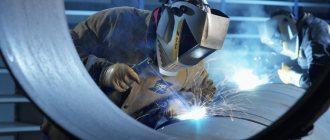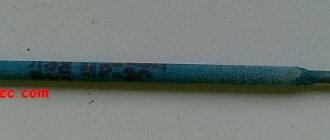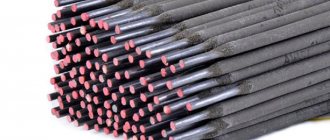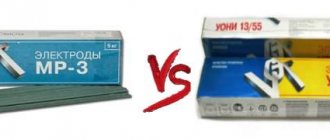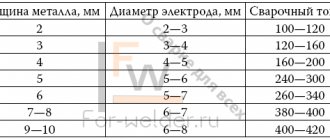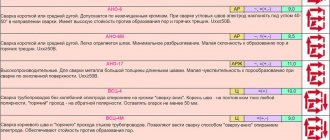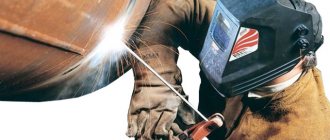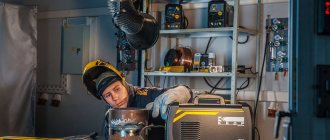Special electrodes for aluminum make it possible to form a strong seam that is not inferior in characteristics to the base metal. The technology for creating unbreakable connections manually is used in everyday life or when repairing machinery and equipment in the field. The electrodes have a special coating that destroys the refractory film of oxides on the surface of parts made of aluminum alloys.
Electrodes are used to weld pure aluminum and its alloys.
Briefly about aluminum welding technology
Aluminum and alloys based on it are characterized by low specific gravity and high strength. The melting point does not exceed +660°C. When heated, the shade of the metal remains unchanged, which makes it difficult to understand the condition of the parts.
In addition, upon contact with the atmosphere, a strong film of oxides is formed on the surface, which is destroyed when heated to +2037°C. Particles enter the weld metal, reducing the mechanical strength of the joint. Before welding, the film is removed chemically or mechanically, or special electrodes are used.
Important features of metal
Aluminum was first produced in 1825, and 30 years later the first technology for industrial production and purification of the metal was developed. Until the beginning of the 20th century, the cost of the material was comparable to gold, but subsequently the price fell due to the introduction of electrolysis techniques.
Aluminum is widely used for the manufacture of various structures, has a low specific weight, is easy to stamp, does not form toxic or carcinogenic compounds, and is resistant to corrosion processes under normal operating conditions.
Chemical properties
Under natural conditions, there is an oxide layer on the surface of the metal that is resistant to the effects of pure oxygen, nitric and sulfuric acids. As the temperature rises, nitric acid destroys the film; concentrated hydrochloric acid and sulfuric acid diluted with water have a similar effect.
When welding, nitric acid destroys the metal.
Film formation inhibitors are tin or gallium, which are introduced into the alloy.
Pure aluminum reacts with oxygen in the air and halogens (with the exception of fluorine, which requires heat to combine).
Physical properties
Main properties of the material:
- The metal has a silver-white color, the specific gravity is 2.712 g/cm³ (3 times lower than that of carbon steels).
- The temperature of transition to the liquid phase is in the range of +658...660°C (depending on the degree of purification from impurities), the melt begins to boil at +2519°C.
- The material forms alloys with other metals, which have improved mechanical characteristics. For example, the introduction of silicon makes it possible to obtain silumin, which is used for casting parts, and a compound with magnesium (duralumin) is used in the automotive and aviation industries.
- Aluminum has increased electrical conductivity (at 65% compared to purified copper), and also transmits heat well, which makes it possible to use the metal in the production of radiators. Polished plates have increased reflectivity.
Requirements for electrodes for aluminum
A standard electrode for manual aluminum welding has a carbon or metal rod with a coating that destroys the oxide film and at the same time protects the melt in the joint area from premature contact with atmospheric air.
To perform work in domestic conditions, an inverter with a rectifier unit is used to produce constant voltage. The device is suitable both for connecting small-sized elements and for sealing cracks in the housings of units cast or stamped from aluminum alloys.
The electrode protects the melt from premature contact with air.
If a plasma installation is used, the equipment is designed to use a tungsten rod with a diameter of 1.5 mm, which does not melt during the welding process. A filler wire made of aluminum alloy is fed into the arc discharge zone. The technology is characterized by increased speed of work and involves the use of alternating current.
We recommend reading Description of rutile-coated electrodes
In automatic welding, flux and filler wire are supplied to the joint area.
Automated lines are designed for accelerated welding of parts with a thickness of up to 4 mm.
Necessary alloying components in the composition of electrodes
Aluminum electrodes have a central core of wire, which may contain additives:
- manganese, which increases the resistance of the melt to corrosion;
- silicon, which improves the weldability of parts;
- magnesium, which increases the strength of the joint;
- silicon with magnesium, which improves the thermal stability of the seam.
Electrodes for inverter
There are no specialized parts made from technically pure aluminum or alloys for inverter welding. When connecting the inverter, you must select direct current and connect the wires in reverse polarity (negative pole to the workpieces). This technology allows you to destroy the oxide film with an arc; with direct switching, it is difficult to weld aluminum with an inverter.
High-quality electrodes for welding with an inverter give a good seam.
Electrodes for inverter welding
Characteristics for arc welding
When performing arc welding with a consumable electrode, a constant discharge is formed, which ensures a rapid transition of the rod material into a liquid (as well as gaseous) state of aggregation.
Welding aluminum parts takes 2-3 times less time than joining steel sheets of similar dimensions. Since when the electrode stops, a layer of slag forms on the tip of the rod and the surface of the weld, re-igniting the arc is difficult. Experienced welders form a seam until the length of the electrode is completely used up.
Electrodes for arc welding.
The surface of rods for welding aluminum alloys is covered with a dense layer consisting of chlorine and fluorine compounds with alkali or alkaline earth metals. When the arc burns, the flux enters into chemical reactions with the oxide film, forming slags insoluble in aluminum, which are then removed from the surface of the weld mechanically.
There are electrodes coated with alloying metals, but additives are usually added to the melting rod.
Features for duralumin
In addition to standard electrodes for aluminum (which are theoretically suitable for working with duralumin), there are special products that differ in the chemical composition of the rod and coating. For example, the Swedish manufacturer ESAB produces products under the OK-9620 or OK-9650 brand, designed for duralumin.
Swedish electrode manufacturer ESAB.
Electrodes for inverter welding
You can often hear a question from inexperienced welders about whether it is possible to weld aluminum using an inverter.
And what electrodes to use? The answer to this question is very simple - if you do not have special equipment and you decide to weld with electrodes, you must use an inverter. Since aluminum is a difficult metal to weld, the use of an inverter will ensure the formation of an even and high-quality seam. Here are the main advantages of the inverter:
- Consumes relatively little electricity . In this case, high efficiency is achieved.
- Protects against voltage surges and allows you to maintain a stable current throughout the entire welding process.
- Compactness of the device. It has small dimensions and is convenient to use in any conditions.
- Can work with difficult to compatible alloys .
- Any type of electrode can be used . Therefore, all coated electrodes that can be used for welding work on aluminum structures are suitable for the inverter.
IMPORTANT! When welding aluminum, you must use direct current of reverse polarity.
In this case, cathode sputtering is formed, which destroys the oxide film on the metal surface. If you use straight polarity, the film will not collapse, and welding the structure will be very difficult. With reverse polarity, there should be a stable supply of strong current. Since a decrease in current strength can lead to poor combustion of the welding arc and the formation of a poor seam. The inverter will help maintain the desired current level and ensure stable welding.
Popular brands of electrodes for aluminum with descriptions
Common electrodes for welding aluminum alloys:
- OK series from the Swedish company ESAB;
- OZA-1 and 2, designed to work with technical grade aluminum or silumin, respectively;
- OZANA-1 and 2, similar in characteristics to OZA 1 and 2;
- UANA-6, supplied by Energomash from Sumy (Ukraine).
OK (alkali-salt)
The manufacturer offers several types of products:
- OK-9610 are designed for processing pure aluminum. The surface of the rod is covered with a layer of chlorine and fluorine salts with a binder. The manufacturer does not require the products to be warmed up before work, but welders immerse the electrodes in water heated to +80°C. The resulting seam can be easily cleaned from slag with a brush, and there is no melt spatter during welding. Can be used to connect duralumin blanks.
- OK-9620 are designed to work with alloys containing manganese and magnesium up to 3%. Manganese is introduced into the electrode rod, and a protective coating based on salts is preserved. Before starting work, the electrodes must be heated to +220°C; the resulting connections can withstand small alternating loads.
- OK-9650 is distinguished by the use of an aluminum-manganese alloy core. The coating consists of a mixture of alkalis and salts. It is allowed to use the electrode as a welding wire when connecting parts with a non-consumable tungsten rod.
OK electrodes are designed for processing pure aluminum.
OZA-1 and 2
OZA-2 electrodes are used for horizontal or vertical welding.
Model OZA-1 is designed for horizontal or vertical welding of sheets of pure aluminum grades A0-A3. Before starting work, the edges must be cleaned of oxides, and the parts must be heated in an oven to +250...+400°C. The slag layer that forms should be removed with a wire brush and the surfaces should be washed with warm water.
We recommend reading Welding with tungsten electrodes
OZA-2 electrodes are intended for correcting defects in castings made of silumin grades AL-4 or AL-11 (with preliminary cleaning of the edges and heating). The slag is washed off with warm water and cleaned off with steel brushes.
Before use, the electrodes must be calcined in an oven for an hour at temperatures up to +200°C. The weld metal obtained using OZA-1 consists of aluminum with impurities of silicon, titanium and iron (the proportion of components is in the range of 0.1-0.4%). The electrodes have a length of 350 or 400 mm (diameter 4 and 5 mm, respectively).
The welded connection allows bending up to 170° and withstands loads up to 70 MPa.
OZANA-1 and 2
OZANA-1 electrodes for processing pure aluminum of grades A0, A1 or A3 require cleaning the edges and heating the parts to +200°C (with the exception of workpieces with a wall thickness of less than 10 mm). Designed to work in the lower position, the formation of ceiling seams is allowed.
OZAN electrodes require parts to be heated to +200°C.
Electrodes of the OZANA-2 model are used for connecting parts made of silumin or sealing cracks in castings.
When carrying out work, additional flux may be required (the outer part of the OZANA-1 and 2 rods is coated with a mixture of salts and a binder).
Electrodes of the OZANA series are calcined for 30 minutes at a temperature of +150°C before use; the weld metal contains silicon and iron. Rods with diameters of 3, 4 and 5 mm are available (lengths 320, 360 and 390 mm, respectively), the welding current depends on the cross-section of the rod. The resulting connection can withstand loads up to 90 MPa and bending up to 140°.
LEZ electrodes
The LEZ enterprise (Losinoostrovsky Electrode Plant) produces electrodes for welding structural and alloy steels. The catalog contains more than 50 items, differing in chemical composition and type of protective coating. There are no rods for welding aluminum alloys in the production line, so you need to choose products from another plant (for example, ESAB or SpetsElectrode).
LEZ electrodes are used for welding structural steels.
UANA-6 for aluminum and magnesium alloys
UANA-6 electrodes with salt coating allow welding in horizontal and vertical directions. Before starting work, the edges of the parts must be cleaned and heated with a gas burner or the workpieces must be placed in the oven. Please note that electrodes are not suitable for working with parts with a mating edge thickness of less than 10 mm. Before use, the rods must be placed in an oven heated to +200°C (calcination time up to 90 minutes).
UANA-6 electrodes have a salt coating.
When using UANA-6, an even seam without voids is formed. The slag crust remaining on the surface is removed mechanically (adhesion to the base is low). The electrodes have a diameter from 3 to 6 mm (in increments of 1 mm), the current strength in the circuit ranges from 70 to 180 A (depending on the direction of the seam and the cross-section). The products are manufactured by the Ukrainian enterprise Energomash (Sumy), there is no information about other suppliers.
UTP 48 with silicon
The UTP 48 electrode is intended for welding or surfacing parts made of aluminum-silicon alloy containing up to 12% silicon (the rod has a similar chemical composition).
The resulting seam has a yield strength of 80 MPa, temporary tensile strength reaches 180 MPa with a relative elongation of 5%. The metal of the joint can withstand heating up to +573°C. Electrodes can be used for welding in the downward, vertical and angular positions, but the increased fluidity of the melt in the pool should be taken into account.
Electrodes of the UTP 48 brand are needed for welding aluminum-silicon alloy.
UTP 48 products are designed for direct current of reverse polarity (with the positive pole supplied to the electrode). Electrodes with a diameter of 2.5 to 4 mm with a standard length of 355 mm are offered (on individual orders, the manufacturer produces products with increased or decreased dimensions). The current strength in the power circuit during welding is 50-130 A.
Foxweld for gas welding
The Foxweld company offers equipment for welding aluminum with a tungsten electrode with the supply of shielding gas, which prevents the saturation of the melt with harmful substances. To form a seam, wire is fed into the welding zone; the cross-section and composition are selected depending on the characteristics of the units being connected.
We recommend reading: What electrodes are used on stainless steel?
Foxweld electrodes prevent the melt from becoming saturated with harmful substances.
The advantage of the equipment is the non-contact method of arc initiation. The equipment body is equipped with regulators for welding current parameters (information is displayed on a small-sized liquid crystal display).
The equipment is designed for connection to a household alternating current network with a voltage of 220 V. The current strength in the welding circuit depends on the model (for example, the basic 180 DC PULSE has a range of 10-180 A). It is possible to remove the burner and install a handle for piece consumable electrodes (MMA technology). In this case, the seam is protected with molten flux. The dimensions of the electrode are selected by the welder, focusing on the length of the joint and the thickness of the workpieces.
Surfacing of parts made of aluminum alloys
The main difficulties in surfacing products from aluminum alloys
All aluminum alloys used for the production of parts are divided into casting and wrought.
In turn, these alloys can be heat-strengthened and not hardened by heat treatment, as well as cold-worked, i.e., having surface-plastic hardening. Depending on these conditions, to restore parts made of aluminum alloys by electric arc surfacing, it is necessary to use various welding techniques, use additional equipment for heating the products, or select technological installations that allow modulating the heat input into the product. Along with these problems, when restoring parts made of aluminum alloys, difficulties arise due to the peculiarities of the thermophysical and metallurgical properties of the material itself. The main difficulty in surfacing aluminum alloys is the removal of the oxide film from the surface of the weld and filler materials. The surface of aluminum and its alloys is covered with a refractory oxide film that melts at a temperature of 2050 °C. This film makes it very difficult to fuse the base and filler metals, so the welded edges must be thoroughly cleaned mechanically or chemically. It should be borne in mind that when heated to 400...500 °C, the strength of aluminum drops sharply and the part can collapse even under the influence of its own weight.
An oxide film forms on the surface of aluminum almost instantly due to the very high activity of aluminum towards oxygen. The thickness of the oxide film depends on the operating conditions of the product and the duration of exposure to the oxidizing environment. However, due to its high density, the thickness of the oxide film usually does not exceed 0.1 mm. The presence of an oxide film on the surface prevents the fusion of the metal, and its entry into the weld pool causes porosity of the weld bead. Porosity usually occurs due to the dissociation of oxides and the entry of water vapor and organic pollutants into the weld along with the film. To eliminate the harmful effects of the oxide film, before surfacing, aluminum products must be prepared using the following technology:
- hot water rinsing to remove organic contaminants;
- burning oil with a gas burner (for parts operating in an oil bath);
- cleaning the surface mechanically - turning, milling, cleaning with a metal brush.
Removal of the oxide film can be carried out chemically: etching in a 10% alkali solution, followed by washing in water and passivation in a 3% solution of nitric acid.
Products made of aluminum alloys are usually deposited using alternating current or direct current of reverse polarity. This is due to the fact that under these conditions the oxide film is destroyed during arc combustion under the influence of the so-called “cathode destruction mechanism”. The combination of preliminary preparation of the metal with the action of the mechanism of cathodic destruction of the oxide film makes it possible to obtain a weld bead of sufficiently high quality.
Aluminum alloys have high thermal conductivity and a high casting expansion coefficient. Therefore, for surfacing aluminum products, it is necessary to use powerful heat sources with a high degree of thermal energy concentration. In addition, repair and restoration work requires rigid clamping devices to prevent warping during surfacing.
Additional difficulties when surfacing aluminum products arise due to the tendency of some alloys to crack.
The appearance of hot cracks is associated with large casting shrinkage of the alloy during the crystallization process and the excess of the metal deformation rate over its deformability in the temperature range of brittleness. The fight against cracking can be carried out both technologically and metallurgically. Technological measures include the use of preheating of the product, optimization of welding mode parameters, and pulsed heat input. Metallurgical measures include the use of filler materials of high purity, alloying the weld bead with components that increase the ductility of the alloy, and modification of the metal with refractory elements.
Surfacing of products made of aluminum alloys can be carried out either with a consumable electrode or with a non-consumable electrode (tungsten) with the supply of filler wire. Inert gases argon or helium are used as a protective medium. For surfacing with a non-consumable electrode, installations such as UDG-500, UDAR, ISVU-315, TIR-300D are used. For surfacing products made of aluminum alloys with a three-phase arc using non-consumable electrodes, an installation of the UDGT-315 type is used. For surfacing products with a consumable electrode, welding rectifiers such as VDG-500, VS-600 or other similar ones with a rigid characteristic, used for semi-automatic welding, are used.
Making electrodes for aluminum at home
Novice welders and experienced craftsmen sometimes make electrodes themselves, using wire with a chemical composition identical to the parameters of the parts being joined. It should be noted that homemade products do not have stable characteristics and are unsuitable for welding critical joints. Electrodes are used for repairing components that are not subject to high mechanical or vibration loads, in domestic or field conditions.
What you need
For production you will need:
- measuring tool (ruler or tape measure);
- wire cutters or hacksaw;
- wooden or metal stand for drying products;
- a coil of aluminum wire with a diameter of 3-4 mm;
- powdered chalk;
- silicate glue (or liquid glass);
- container for mixing coating components;
- brush for applying the composition;
- a dry cloth to remove drops of liquid coating from the table or tip of the future electrode.
To make electrodes you need wire cutters.
Step-by-step instruction
The sequence of actions when making homemade electrodes for arc welding of aluminum parts:
- Cut aluminum wire with pliers or a circular saw into pieces having a length of 250 or 300 mm (in accordance with the standards).
- In a separate container, mix powdered chalk with silicate glue. The resulting mass should have a uniform consistency without lumps or foreign impurities.
- Carefully apply the coating to metal workpieces (for example, with a narrow brush). The thickness of the protective layer should be in the range from 1.5 to 2 mm; if this requirement is not met, the quality of welding is reduced. The tip intended for installing the electrode into the handle is not covered with coating.
- Place the products by the tips on the stand and wait for the mass to harden (the rate of moisture evaporation depends on the thickness of the layer and the ambient temperature). It is possible to speed up the process by calcining the workpieces in the oven.
Video instruction
The videos present an algorithm of actions performed in the manufacture of homemade electrodes for welding aluminum alloys. The technology can be used without changes; adjustments related to the list of available equipment are allowed.
Physico-chemical composition
The composition of aluminum electrodes for arc welding varies greatly among different brands. They are still based on pure aluminum, the mass of which is overwhelming, but the main properties are determined by various additives that can be used for welding alloys and so on. For example, grade OZA 1 is intended for working with pure metal and it consists of almost 99% of it. The remaining 1% are additives, which include 0.5% silicon, 0.25% titanium, 0.2% iron and other impurities. If the materials are intended for welding aluminum-silicon alloys, then they may contain about 12% silicon, and the rest is aluminum.
Electrodes for aluminum welding grade OZA 1
Recommendations from the experts
Advice from experienced welders to novice welders:
- It is recommended to weld workpieces with electrodes made from the same grade of alloy. Information about the chemical composition of the instrument is indicated by the manufacturer on the packaging.
- It is necessary to take into account the ratio of the thickness of the workpieces and the diameter of the electrode. When using a tool with a larger cross-section, it is possible to burn through sheet aluminum.
- It is not recommended to dry consumables more than 2-3 times due to coating degradation.
- Before starting electric welding, the edges of the mating parts must be treated with an abrasive tool that removes oxides.
Beginner welders are recommended to practice welding structures from thick-walled workpieces or waste. As you gain experience, you can move on to joining sheets.
Due to the increased fluidity of the melt, it is difficult to form a thin and uniform seam. It is recommended to weld large assemblies in several stages with breaks to clean the joints from slag.
